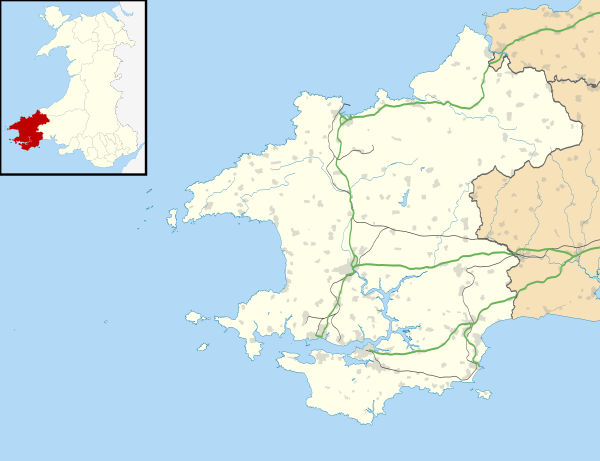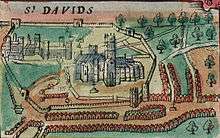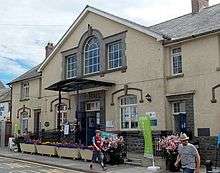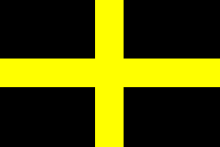St Davids
| St Davids | |
| Welsh: Tyddewi | |
 St David's Cathedral |
|
 St Davids |
|
| Population | 1,841 [1] (2011) |
|---|---|
| OS grid reference | SM755255 |
| Community | St David's and the Cathedral Close |
| Principal area | Pembrokeshire |
| Ceremonial county | Dyfed |
| Country | Wales |
| Sovereign state | United Kingdom |
| Post town | HAVERFORDWEST |
| Postcode district | SA62 |
| Dialling code | 01437 |
| Police | Dyfed-Powys |
| Fire | Mid and West Wales |
| Ambulance | Welsh |
| EU Parliament | Wales |
| UK Parliament | Preseli Pembrokeshire |
| Welsh Assembly | Preseli Pembrokeshire |
|
|
Coordinates: 51°52′55″N 5°16′08″W / 51.882°N 5.269°W
St Davids or St David's[2][3] (Welsh: Tyddewi, [tɨː ˈðɛwi], lit. "David's house") is a city, parish[4] and community (full name St David's and the Cathedral Close) in Pembrokeshire, Wales. Lying on the River Alun on St Davids Peninsula, it is Britain's smallest city in terms of both size and population, the final resting place of Saint David, Wales's patron saint, and the de facto ecclesiastical capital of Wales. St Davids was given city status in the 16th century due to the presence of St David's Cathedral but lost this in 1888. City status was restored in 1994 at the request of Queen Elizabeth II.
History
Tradition states that David was born to Saint Non at what is now St Non's, just to the south of the city, in about AD 500. It is said that he was baptised at Porthclais, now the city's port, and was brought up by his mother at Llanon. St David may also have been educated at Ty Gwyn, Whitesands, by St Paulinus.
In the 6th century, David founded a monastery and church at Glyn Rhosyn (Rose Vale) on the banks of the River Alun. The area was originally known in the Welsh language as Mynyw and to the Romans as Meneva or Menevia. The monastic brotherhood that David founded was very strict — besides praying and celebrating masses, they cultivated the land and carried out many crafts, including beekeeping, in order to feed themselves and the many pilgrims and travellers who needed lodgings. They also fed and clothed the poor and needy.[5] The settlement that grew up around the monastery was called Tyddewi meaning "David's house". In 519 the archbishopric of Caerleon in the county of Monmouth was transferred to Mynyw, which was renamed "St Davids" in honour of the archbishop and saint by whom the transfer was accomplished.[6] The original cathedral built on the site was often plundered by the Vikings and was finally burnt and destroyed in 1087. The present cathedral was built by the Normans and contained many relics, including the remains of St David. It was visited by many pilgrims, many of whom were nobles and kings, including William the Conqueror in 1077, Henry II in 1171, and Edward I and Queen Eleanor in 1284.[6] Pope Calixtus II decreed that two pilgrimages to St Davids were equivalent to one to Rome ("Roma semel quantum dat bis Menevia tantum"). Because of this, a vast income was raised from visiting pilgrims in the Middle Ages.[7] Pilgrimages later fell out of favour due to practices such as the selling of indulgences, and the income from them faded away.
By the 19th century the city of St Davids was isolated and neglected, and was described as follows in the Penny Cyclopaedia:[6]
At present its appearance is that of a poor village, the houses, excepting those of the clergy, being in a ruinous state. The locality is lonely, and the neighbouring district wild and unimproved; but it is still an interesting place as the seat of a large episcopal see, with a fine cathedral and the remains of other magnificent religious edifices.
Since then, better transport and the advent of tourism have helped the city prosper again.
City status


In the 16th century a town was recognised as a city by the English Crown if it had a diocesan cathedral within its limits, but this link was abolished in 1888[8] and St Davids lost the right to call itself a city. In 1991 St Davids town council proposed that a case for city status, which the residents had long considered it to have anyway, should be promoted in connection with the 40th anniversary of the coronation of Queen Elizabeth II, and in 1992 the Home Office agreed to refer the matter to Buckingham Palace. In 1994, at the request of the Queen, St Davids was again granted city status along with the Northern Irish town of Armagh, "In recognition of their important Christian heritage and their status as cities in the last century".[8] The letters patent conferring city status were formally presented by the Queen in a ceremony at St David's Cathedral on 1 June 1995.[9]
Governance
St Davids City Council is a community council composed of twelve councillors.[10] The City Council employs one City Clerk and one Financial Officer.[10] The currently elected presiding officer is The Rt Wp The Mayor of St Davids Cllr John George.[10] Sir David Jones of Fachelich was recently presented with the key to the city.
St Davids today
Next to the cathedral, the 13th-century Bishop's Palace is a ruin maintained by Cadw and open to visitors. St Davids was once a marcher borough, within which lay the hundred of Dewisland. In 1603 the antiquarian George Owen described it as one of five Pembrokeshire boroughs overseen by a portreeve.[11]
Saint Non's Well overlooks the Pembrokeshire Coast Path and St Brides Bay.
In addition to the cathedral, notable features of the city include the 14th-century Tower Gate, the Celtic Old Cross and a number of art galleries. St Davids is also a base for walking and water sports. It has several hotels, a pharmacy, shops and galleries, and a youth hostel, and a number of pubs. The entire coastline around St Davids forms part of the Pembrokeshire Coast National Park.
St Davids lifeboat, located at St Justinian, has saved an estimated 360 people since the first lifeboat was located there in 1869; and four lifeboatmen have died while saving others.[12] The Irish Sea area includes a large number of offshore rocks and islands, and is notorious for strong tides.[13]

Culture and sport
The city hosted the National Eisteddfod in 2002. The Archbishop-designate of Canterbury, Dr Rowan Williams, was inducted into the Gorsedd of Bards, a historic order of Druids.[14]
The St Davids Penknife Club is a group of people dedicated to voluntary fund raising for local groups and charities.[15]
St Davids has a rugby union club, St. Davids RFC, which competes in the SWALEC League Six West.[16]
Whitesands Bay, about two miles west of St. Davids, is a popular watersports resort. It has been described as the best surfing beach in Pembrokeshire and one of the best tourist beaches in the world.[17]
Education
Ysgol Dewi Sant (St David's School) is the local secondary school, with pupils in Years 7–13 (i.e. aged from 11 to 18).[18] Ysgol Bro Dewi (Dewisland School) is a Voluntary Controlled Primary School, with pupils from Reception to Year 6.
Notable people
- Asser, mentor of King Alfred the Great, and writer of his biography, was a monk at St Davids before being called into Alfred's service.
- William Barlow, expert on magnetism and Anglican cleric, was born in St Davids some time during the tenure of his father, also William Barlow, as bishop (1536–48).
- Henry Hicks (1837–1899), eminent surgeon and geologist, was born at St Davids and practised there from 1862 until 1871.
- Thomas Tomkins (1572–1656), eminent English musician and composer, was born in St Davids.
Twin towns
St Davids is twinned with: [19]
See also
- Saint David's Day
- Chapel of St Non
- Annales Cambriae
- Bishop of St Davids
- Diocese of St Davids
- Roman Catholic Diocese of Menevia
References
- ↑ Office for National Statistics 2011 census – St. David's and the Cathedral Close C
- ↑ Parish Headcounts for Pembrokeshire (based on 2001 Census) at Office for National Statistics. Retrieved 2011-08-01
- ↑ As specified in New Oxford Dictionary for Writers and Editors OUP 2005. The name is often spelt without its possessive apostrophe, including by the St Davids City Council
- ↑ "GENUKI: St David's". Retrieved 7 March 2016.
- ↑ Jones,, Rhys James (28 February 1994). "Saint David and Saint David's Day". Retrieved 21 June 2012.
- 1 2 3 Anon (1837). "David's, St.". The Penny Cyclopædia of the Society for the Diffusion of Useful Knowledge. London: Charles Knight and Co. 7–8: 317. Retrieved 21 June 2012.
- ↑ St David's day, Pembrokeshire at History.UK.com, 16 February 2003. Retrieved on 1 August 2011
- 1 2 Beckett, J. V. (2005). City status in the British Isles, 1830–2002. Ashgate Publishing, Ltd. p. 22. Retrieved 31 January 2012.
- ↑ Alderson, Alf (3 March 2001). "The small city with the big kicks". The Guardian. Guardian News and Media Limited. Retrieved 21 June 2012.
- 1 2 3 http://www.stdavids.gov.uk/council-information/
- ↑ Owen, George, The Description of Penbrokshire by George Owen of Henllys Lord of Kemes, Henry Owen (Ed), London, 1892
- ↑ St Davids Lifeboat Station: Introduction at Royal National Lifeboat Institution (RNLI). Accessed on 1 August 2011
- ↑ St Davids Lifeboat Station at Royal National Lifeboat Institution (RNLI). Accessed on 1 August 2011
- ↑ St Davids and St Davids Cathedral, Pembrokeshire at Wales in Style. Accessed on 1 August 2011
- ↑ "St Davids Penknife Club". Retrieved 2011-07-03.
- ↑ SWALEC League Six West at Welsh Rugby Union
- ↑ http://www.pembrokeshire.gov.uk/content.asp?id=8093&d1=0
- ↑ "The Curriculum". Ysgol Dewi Sant website. 2014. Retrieved 15 January 2014.
- ↑ "St Davids City Council – Twin towns". Retrieved 20 September 2014.
Further reading
- O'Malley, Brian Brendan, comp. (1985) A Pilgrim's Manual: St. Davids. Marlborough: Paulinus Press ISBN 0-907740-13-8
External links
| Wikimedia Commons has media related to St David's. |
| Wikivoyage has a travel guide for St Davids. |
- Independent St Davids tourism website
- Coast and Country Cottages St Davids tourism website
- St Davids City Council
- St Davids at www.visitpembrokeshire.com (official council tourism website)
- St Davids RFC
- St Davids at DMOZ
